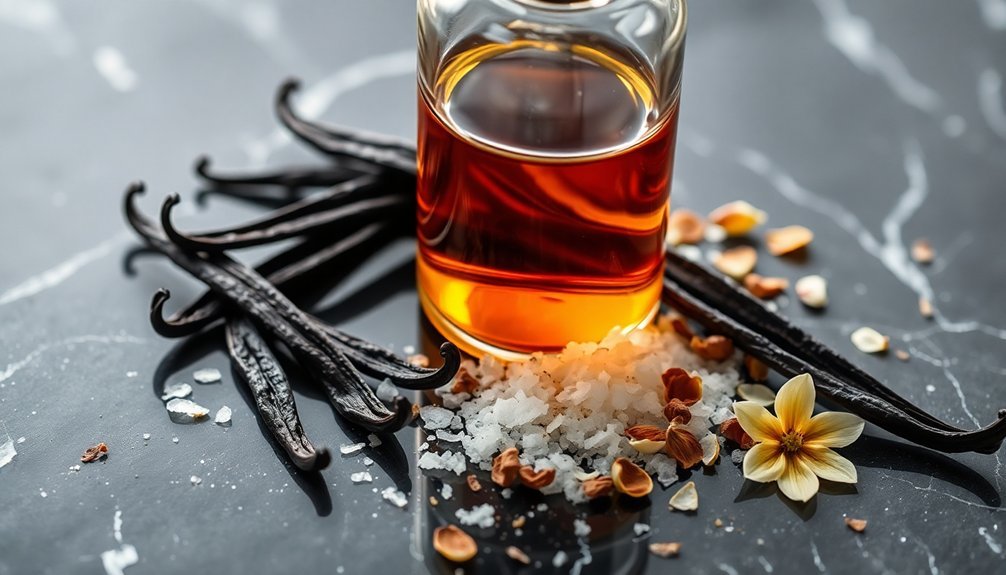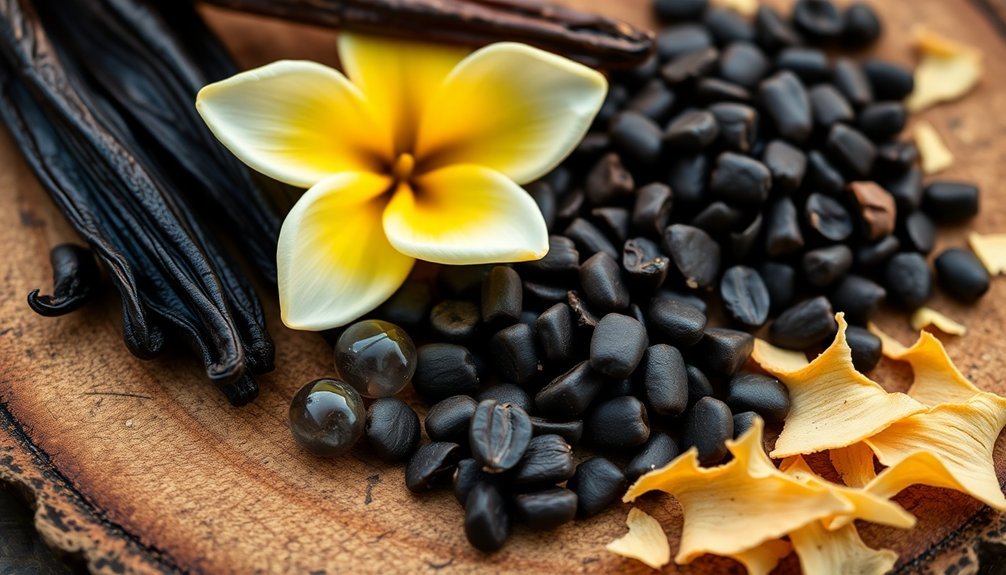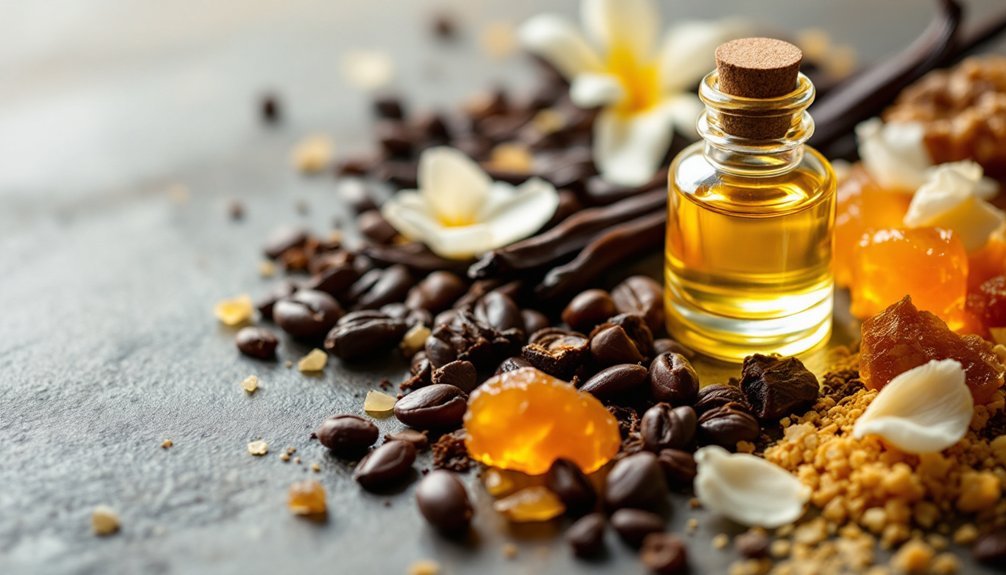A vanilla perfume base starts with either natural vanilla absolute or synthetic vanillin as your foundation. You'll need to combine this with carrier oils like jojoba or sweet almond oil at an 80% concentration ratio. Add fixatives such as benzoin or labdanum to help the scent last longer. For depth, you can include complementary notes like sandalwood, bergamot, or tonka bean. The art of vanilla perfumery opens up endless aromatic possibilities.
Essential Vanilla Components for Perfume Making

The essential components of vanilla perfume revolve around its star ingredient, vanillin, which provides the characteristic sweet and powdery aroma that perfume makers seek.
You'll find this key compound offers burnt almond notes and spicy undertones that create a creamy warmth in your fragrance.
To enhance your vanilla base, you can incorporate vanilla CO2 extracts, which deliver depth similar to natural vanilla beans. For best results, avoid storing vanilla compounds in contact with iron containers.
These components work well with both alcohol and oil-based formulations, though they're less effective in water-based solutions.
You'll want to contemplate adding rare resins or amber to enrich the musky, soft profile of your vanilla perfume.
When you're working with vanilla components, remember they're particularly effective in gourmand, oriental, and floral fragrance families.
Natural Carriers and Base Notes
When creating your vanilla perfume, you'll need to select a carrier oil that both complements and stabilizes your fragrance, with jojoba and sweet almond oil being top choices for their excellent absorption rates and skin compatibility.
Your base notes will serve as the foundation of your perfume, where vanilla absolute pairs beautifully with complementary scents like sandalwood, vetiver, or bergamot.
The right combination of carrier oil and base notes can transform a simple vanilla scent into a complex, long-lasting fragrance that evolves on your skin throughout the day. For optimal results, aim for a carrier oil concentration of 80% in your vanilla perfume blend.
Essential Carrier Oil Selection
Selecting appropriate carrier oils forms the cornerstone of a successful vanilla perfume base.
You'll want to choose oils that both complement vanilla's warm nature and guarantee proper fragrance longevity. Jojoba oil stands out as an excellent choice, as it mimics your skin's natural oils and helps retain the vanilla scent longer. The process of infusing vanilla requires daily agitation of mixtures to properly blend the scent with your chosen carrier oil.
For your vanilla perfume base, consider these carrier oil options:
- Fractionated coconut oil for a lightweight, quick-absorbing foundation
- Sweet almond oil to add nourishing properties and subtle depth
- Jojoba oil to enhance fragrance duration and skin compatibility
When creating your blend, maintain an 80:20 ratio of carrier to essential oils.
If you have sensitive skin, stick with hypoallergenic options like jojoba or sweet almond oil. For oily skin types, opt for lighter carriers like grapeseed oil.
Vanilla Base Note Foundations
Building a solid vanilla base requires careful selection of natural foundations that anchor your fragrance.
You'll want to start with pure vanilla beans or extract as your primary base, which provides the rich, sweet aroma essential to any vanilla perfume. The key compound you're working with is vanillin, responsible for that signature creamy sweetness.
To create depth, you'll need complementary base notes.
Consider combining vanilla with amber for warmth, patchouli for earthiness, or sandalwood for sophisticated depth. These pairings help stabilize your fragrance while adding complexity.
You can enhance the vanilla foundation by incorporating coumarin for a hay-like warmth or anisaldehyde for a subtle spicy note.
Synthetic Elements in Vanilla Fragrances

In modern perfumery, synthetic elements have revolutionized vanilla fragrances through their cost-effective and reliable properties. At the heart of these innovations, you'll find vanillin, a synthetic compound that's twenty times cheaper than natural vanilla extract while delivering consistent, powerful results.
You'll appreciate these key advantages of synthetic vanilla elements in perfumes:
- Superior stability and longer shelf life
- Consistent scent profile across batches
- Easy blending with other fragrance notes
While natural vanilla contains over 200 compounds, synthetic vanillin offers predictability and efficiency in perfume creation.
You can find this versatile ingredient in many luxury fragrances, where it adds a sophisticated sweetness and helps harmonize different scent elements. For mass production, synthetic vanillin's high availability and cost-effectiveness make it an ideal choice.
Blending Techniques for Vanilla Bases
Now that you understand synthetic vanilla components, let's explore the artistry of blending vanilla bases.
You'll want to start with a 3:2:1 ratio when combining your fragrance notes, using vanilla as your foundational base note. For the perfect blend, select three to five complementary oils from different note families.
When working with vanilla, you can create depth by combining it with woody notes like cedarwood or sandalwood. If you're seeking a fresher scent, try adding citrus top notes such as bergamot.
You'll need to use carrier oils like jojoba or sweet almond oil as your base, and don't forget to add a preservative like vodka or witch hazel to extend the fragrance's life.
Store your creation in an amber glass bottle to protect it from light degradation.
Creating Depth With Complementary Ingredients

To enhance your vanilla perfume base, start by adding woody notes like sandalwood or cedarwood, which provide a rich foundation and remarkable depth.
You'll find that layering essential oils, particularly warm spices or deep florals, creates intricate dimensions within the vanilla core.
Combining vanilla with natural resins such as benzoin or labdanum introduces complex, balsamic undertones that transform a simple vanilla scent into a sophisticated fragrance.
Woody Notes Deepen Vanilla
While vanilla's sweet and creamy profile forms the heart of many perfumes, woody notes create essential depth and sophistication in fragrance compositions.
You'll find that combining vanilla with woods like cedarwood, sandalwood, and patchouli adds richness and complexity to your perfume base.
The most effective woody notes to blend with vanilla include:
- Cedarwood for fresh, natural depth
- Sandalwood for earthy warmth
- Pine for crisp, outdoorsy elements
When you're crafting a woody vanilla blend, consider how these elements interact with vanilla's sweetness.
The grounding effect of woody notes helps balance the composition, preventing it from becoming overly sweet.
You can further enhance this depth by incorporating citrus notes or adding musk for additional warmth and sensuality.
Adding Essential Oil Layers
Creating depth in vanilla perfumes requires strategic layering of essential oils that complement and enhance the base fragrance.
You'll want to start with floral notes like lavender or jasmine to add complexity while maintaining the sweet undertones. These oils work harmoniously with vanilla's natural warmth.
To prevent your perfume from becoming too sweet, incorporate citrus elements like bergamot or mandarin oil. They'll add a fresh, bright dimension that balances the composition.
For a grounding effect, you can't go wrong with sandalwood oil, which brings earthy, woody notes to your blend.
The key is building these layers gradually, testing the combination after each addition. Remember that each essential oil contributes its unique character, so start with small amounts and adjust until you achieve your desired depth.
Rich Resin Combinations
When crafting a rich vanilla perfume, natural resins serve as powerful anchoring agents that add remarkable depth to your fragrance.
You'll find that combining vanilla with resins like benzoin, oud, or labdanum creates a more complex and lasting scent profile.
To achieve the perfect resinous vanilla blend, consider these essential combinations:
- Pair vanilla absolute with tonka bean for a creamy, sweet foundation
- Add frankincense or myrrh for woody, earthy undertones
- Include balsam of Peru to enhance richness and warmth
The key to successful resin blending lies in gradual layering, allowing each component to harmonize naturally.
You'll want to adjust your combinations based on seasonal preferences – lighter blends for summer, deeper notes for winter wear.
Remember that these resinous elements also act as natural fixatives, helping your perfume last longer.
Popular Vanilla Perfume Combinations

Vanilla perfumes transform into distinctive fragrances through five primary combination styles: woody, citrus, musk, floral, and gourmand. You'll find depth and sophistication when blending vanilla with cedarwood or patchouli for a woody scent, while bergamot and mandarin create invigorating citrus variations. For a sensual experience, combine vanilla with musk, or pair it with jasmine and rose for an elegant floral bouquet.
| Style | Key Notes | Effect |
|---|---|---|
| Woody | Cedarwood, Patchouli | Earthy, Grounding |
| Citrus | Bergamot, Mandarin | Fresh, Uplifting |
| Musk | Musk, Sandalwood | Sensual, Warm |
| Floral | Jasmine, Rose | Elegant, Romantic |
| Gourmand | Tonka Bean, Caramel | Sweet, Indulgent |
Frequently Asked Questions
How Long Does Homemade Vanilla Perfume Typically Last Before Expiring?
Your homemade vanilla perfume will typically last 6-12 months when stored properly. You'll get the best shelf life by keeping it in a dark glass bottle in a cool, dry place.
Can Vanilla Perfume Ingredients Cause Allergic Reactions on Sensitive Skin?
Yes, you can experience allergic reactions from vanilla perfume ingredients. Both natural and synthetic components like vanillin, essential oils, and balsam of Peru may cause skin irritation, especially if you're sensitive.
What Temperature Should Vanilla Perfume Ingredients Be Stored At?
You'll want to store your vanilla perfume ingredients between 10°C and 25°C (50°F to 77°F) in a cool, dark place. Keep them away from direct sunlight and high humidity to maintain quality.
Are Vanilla Perfume Ingredients Safe During Pregnancy?
You'll want to avoid concentrated vanilla essential oils during pregnancy. Instead, opt for milder infused vanilla oils in carrier oils. Always check with your healthcare provider before using any perfume products.
How Can I Test Vanilla Perfume Ingredients for Purity Before Use?
You can test vanilla ingredients through visual inspection, olfactive testing, and chemical analysis. Compare ingredients with standard samples and conduct batch testing to ascertain purity before using them in your perfume.





Leave a Reply